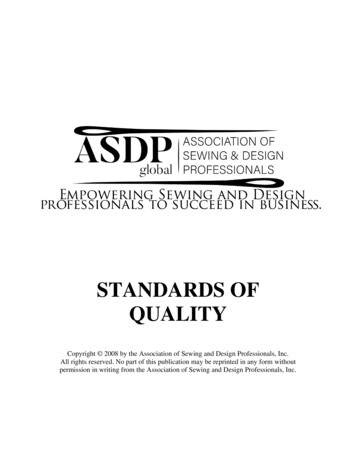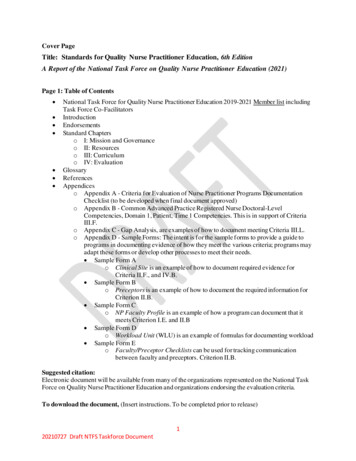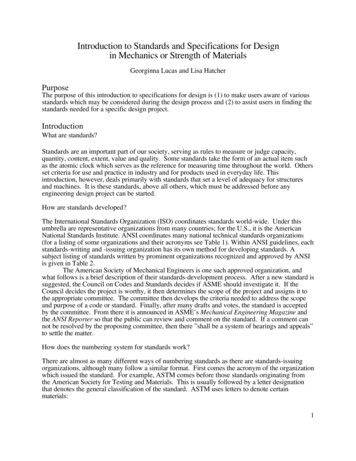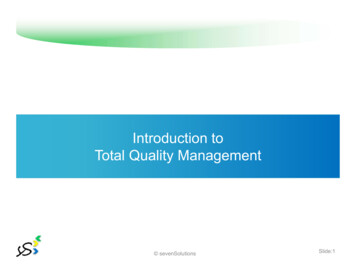
Transcription
STANDARDS OFQUALITYCopyright 2008 by the Association of Sewing and Design Professionals, Inc.All rights reserved. No part of this publication may be reprinted in any form withoutpermission in writing from the Association of Sewing and Design Professionals, Inc.
Table of ContentsTABLE OF CONTENTS . IIACKNOWLEDGEMENTS .VTHE STANDARDS AND PRACTICES COMMITTEE . VIINTRODUCTION . 1SECTION I: . 3QUALITY STANDARDS IN GARMENT CONSTRUCTION. 3SEAMS. 3SEAM FINISHES. 3DARTS . 4DART EQUIVALENTS. 4UNDERLININGS. 5INTERFACINGS . 5INTERLININGS . 6LININGS . 6POCKETS . 7Inseam Pockets . 7Applied Pockets. 7Slashed Pockets. 8EDGE TREATMENTS . 9Bindings . 9Facings . 10Inset Bands. 10Rib-stretch Bands. 11Collars . 11UNDERSTITCHING . 12SLEEVE TREATMENTS . 12Set-in Sleeves . 12SLEEVE/BODICE COMBINATIONS . 13Kimono/Dolman Sleeve. 13Raglan Sleeves . 13Drop Shoulder. 13Deep-cut Arm hole Design. 13SLEEVE FINISHES . 14Sleeve Plackets. 14Cuffs. 14WAISTLINE EDGE TREATMENTS . 15Waistbands. 15Waistline Facings . 15Edge Casings . 16Applied Elastic Waist. 16INTERNAL WAISTLINE TREATMENTS. 16Elasticized Waistlines . 16Internal Casings. 17Waistline Seams . 17CLOSURES. 17Button and Decorative Snap Closures . 17Buttons (including decorative snaps). 18Buttonholes . 18Snapped and Hooked Closures . 19Zippered Closures. 19HEMS AND HEM TREATMENTS . 20ii
DECORATIVE DETAIL. 20Soft Trims. 20Hard Trims. 21Fabric and Stitchery Trims . 21PRESSING . 22SECTION II:. 22QUALITY STANDARDS FOR FIT . 22UPPER BODY AND ARMS . 23Center Back and Center Front Seam or Fitting Lines . 23Side Seam lines . 23Darts . 23Neckline . 24Shoulder Seam line . 25Shoulder Blade and Chest Area . 25Armscye. 26Bust . 26Sleeve . 26LOWER BODY AND LEGS. 27Center Back and Center Front Seam or Fitting Lines . 27Side Seam lines . 27Darts . 27Waistline . 27Hip Area. 28Crotch - Pants. 28Legs - Pants . 29Hemlines . 29MINIMUM EASE COMPARISON CHART . 30BIBLIOGRAPHY . 31SECTION III: . 32QUALITY STANDARDS FOR TEXTILE USAGE . 32SELECTION OF FABRIC . 32CUTTING. 32CONSTRUCTION TECHNIQUES. 33FIT . 33PRESSING . 33SECTION IV: . 34QUALITY STANDARDS FOR VISUAL DESIGN . 34DEFINITIONS OF THE ELEMENTS OF VISUAL DESIGN. 34Space and Line. 34Shape and Form. 35Light. 35Color . 35Texture . 36Pattern . 36THE PRINCIPLES . 37REPETITION . 37PARALLELISM. 38SEQUENCE . 39ALTERNATION . 40GRADATION . 41TRANSITION . 42iii
RADIATION . 42RHYTHM. 43CONCENTRICITY . 43CONTRAST . 44EMPHASIS . 44PROPORTION . 45SCALE . 46BALANCE . 47HARMONY. 47UNITY. 48WORK CITED . 48iv
ACKNOWLEDGEMENTSThe Association of Sewing and Design Professionals wishes to thank the followingexperts for their interest and contribution in reviewing the drafts of these Standards.SEWING TECHNIQUE & FITTEXTILE USAGEREVIEWERS - First DraftClara DitliChris FomellArdis KoesterClaire SchaefferKathleen SpikeMarcy TiltonREVIEWERS - First DraftCamille BrownBarbara DeckertChris FornellArdis KoesterDiane RedgateKathleen SpikeREVIEWERS - Second DraftSusan BennettLynn Brosius-BeachCamille BrownDiane CarithersRenee CharneyBarbara DeckertAnne MirandaDiane RedgateMaj SmithMary Beth StevensonREVIEWERS - Second DraftBonny CannicinoMaria GuzmanAnna McNaughtSally SilversREVIEWERS - Third DraftNancy Bryant Oregon State UniversityRoberta Carr PACC National AdvisorLorraine Howes Rhode lsland School of DesignSandra Keiser Mount Mary CollegeRuth Glock Iowa State UniversityREVIEWERS - First DraftArdis KoesterJan LarkeyMelissa McClureJudith RasbandJo ReimerSally SilversVISUAL DESIGNOriginal DraftKathleen SpikeCatherine StephensonREVIEWER - Second DraftArdis KoesterREVIEWERS - Third DraftJan NunnMarsha McClintockRoxanne SawchukJane SchieltzILLUSTRATIONSTem HorlamusGRAPHIC DESIGNERAllan Stephensonv
Compiled byTHE STANDARDS AND PRACTICES COMMITTEEMembers:Catherine Stephenson, ChairpersonNancy EatonMarsha McClintockJanet NunnRoxanne SawchukJane SchieltzPUBLISHED BY:ASSOCIATION OF SEWING AND DESIGN PROFESSIONALS, INC.Toll-Free: 877-755-0303www.sewingprofessionals.comCopyright 2008 by the Association of Sewing and Design Professionals, Inc.All rights reserved. No part of this publication may be reprinted in any form withoutpermission in writing from the Association of Sewing and Design Professionals, Inc.vi
INTRODUCTIONThe Association of Sewing and Design Professionals, Inc. (the Association)is pleased to endorse the following Standards of Quality. These standardsrepresent the accepted level of quality and the specified level of proficiencyrequired of professional garment sewers. These standards also represent thefive major areas of expertise a professional garment sewer must practice inorder to consistently produce a quality product. The five areas are asfollows: Sewing Technique, Fit (encompassing Pattern Manipulation andAlteration), Textiles and Visual Design.One of the reasons for forming the Association was to provide a venuewithin which sewing and design professionals could adopt standards ofquality for the garments they produce and the services they provide.Standards that specifically address their practices and products had neverbefore been written by and for professional garment sewers. TheAssociation’s hope is that through the use of these Standards, a consistencyin the quality of garment sewing will begin to be commonly recognized bysewing and design professionals throughout North America. TheseStandards will be adopted within the membership of the Association, andhopefully will spread to students and home sewers as well.If Standards of Quality are to work well, they must give specific guidelines,so that sewing and design professionals can have a consistent measurementof quality for their products and services. This document was written givingspecific guideline information that can be used as reference when evaluatinga garment for meeting these quality standards. Each area provides acomprehensive and specific set of standards for each section in a garment'sconstruction. It is important to remember that Standards address a finishedgarment and its appearance; they do not address the steps or techniques thatit takes to achieve the finished result. These Standards can be read as awhole, or used for reference in checking the standard for the individualsections within a garment's design and construction. Visual drawings havebeen included only where necessary as an explanation of that particularstandard(s). Each section is inclusive of all the standards that specificallyaddress that section. Even though this is repetitive, this will aid in its usageas a reference guide when information is needed for a particular sectiononly.1
These standards can be used by individual sewers or by businesses withemployees. They can also be adopted for use by design and sewinginstructors in their classrooms and by authors of custom sewing articles andbooks.The Association would like each member of our organization to adopt theseStandards for all of their products. Use of the Standards in your business isvoluntary, and membership in the Association is not contingent uponmembers using them in their businesses. It is important to remember,however, that the reason for developing and using these standards is toelevate the quality of the products that custom garment sewers provide theircustomers. Through providing quality products, we can increase publicawareness of our skills and the value of our services, leading to greaterincome for and public recognition of Association members.2
SECTION I:QUALITY STANDARDS IN GARMENT CONSTRUCTIONThis section recognizes and identifies the standards for quality clothingconstruction that give a garment a professional, finished look. The followinglist is a guide to producing an objective evaluation of professionally madecustom clothing and alterations. Specific standards in construction can beexpected even though there are many techniques that can produce the samefinished results (i.e. French seams vs. serged seams). These standards applyto almost all sewing construction techniques. Each technique should result ina detail, finish, or area that is attractive or inconspicuous, functional, anddurable. Using these standards as a guideline, the completed garment shouldbe a quality professional garment.SEAMS - When garment shaping and fitting require that two or more piecesof fabric must be joined, then a seam is used to affect that join. Examples ofseams are plain seams, French, flat felled, lapped and serged.1. The type of seam is appropriate to the type of fabric, the position ofthe seam, the projected care of the garment, quality, and design.2. Thread color matches or blends and is of an appropriate weight for thefabric.3. Seams are stitched with the correct stitch length and balanced tension.4. Seams are smooth, with no puckers or pulls, and should lie flat.5. Seam allowances are trimmed evenly unless graded to reduce bulk.6. The seam allowance is appropriate for the type of seam, seam finish,and garment design.7. Intersecting seams are aligned.8. Plaids and stripes match at the seams where possible.9. Seam finishes are appropriate to the dictates of the seam type, fabric,projected garment care, use and quality.10. Seams are well pressed, with no imprint on the outside (seePRESSING).SEAM FINISHES - A seam finish is any technique that is used to make aseam neat, to prevent the seam allowance edges from raveling and/orfraying, to prevent seam allowances from rolling, to prevent stretching andrippling in some seam allowances, and to give the inside of the garment a3
more pleasing appearance. Examples of seam finishes are pinked, overcast,Hong Kong, turned and stitched, and serged.1. The seam finish is appropriate to the garment fabric, the garmentdesign, the intended use of the garment, its quality, and garment care.2. The finish is applied securely so that it remains in place during normalwear and care.3. The finish does not add bulk to the seam.4. The selected finish prevents the fabric from raveling, rolling, orstretching and contributes to the overall neatness of the garment.5. The finishes’ binding or thread color is appropriate to the fashionfabric, unless used for decorative purposes.DARTS - A dart adds three-dimensional shape to a single section of cutfabric. Darts are used most frequently at locations of major body contours-bust, shoulders, waist/hips, elbows, for example--and in apparel that is fittedto the body.1. Stitch length is appropriate to the fabric and to the expected stress atthe stitched location.2. The thread matches the apparel fabric.3. No creases or pressing impressions are present on the face side of thegarment.4. No dimples or bubbles can be seen at the dart point.5. Matching darts appear identical in size and angle.6. The stitching line is smooth without puckers or folds.7. Both ends of the dart are sufficiently secured.8. Darts on heavy or bulky fabrics are slashed, trimmed or balanced, ifneeded, and pressed open.DART EQUIVALENTS - Gathers, pleats and tucks may be used as dartequivalents or as decorative details. They are created during the actualconstruction of the garment, as opposed to being applied to a completedgarment or garment section.1. Gathers are uniform and evenly distributed and stitched so as not toform pleats. Gathers are pressed flat only in the seam allowance. Allvisible basting threads are removed.2. Tucks and pleats are composed of straight, even folds of fabric,uniform in width unless the design requires variation.4
3. The desired grain line is maintained.4. The stitching at the end of the pleat is secure.5. Tucks and pleats are flat and pressed in one direction or as designed,except released tucks and un-pressed pleats.6. Tucks and pleats are free of pressed-in ridges from hidden edges andmarks from basting and pins.7. Tucks and pleats hang straight and even with adequate fullness.UNDERLININGS - An underlining is an appropriate fabric cut to duplicatea garment section, applied to the wrong side of the fashion fabric andhandled as one during the construction of the garment. The primary purposeof underlining is to give additional strength, support, and durability to theouter fabric. It may be used to change the draping quality of the garmentfabric, or to lend opacity to sheer or lightweight fabrics, or to preventwrinkling. Loosely woven outer fabrics may be underlined to preventstretching or sagging.1. The fashion fabric and the underlining fabric relate well—the garmentis neither over-supported nor under-supported for the desired designeffect.2. The fashion fabric and the underlining fabric are compatible as tocolor, care requirements, stretch, quality, and use.3. When on the figure, the two layers of fabric fit smoothly and evenly,with no pulls or puckers.4. The underlining is on the same grain as the garment fabric unless thedesign or the fabrics warrant bias.INTERFACINGS - An interfacing is a special type of fabric applieddirectly to the facing or to the fashion fabric of a garment to give it body andshape.1. The interfacing complements and reinforces the fashion fabric withoutoverpowering it.2. Care requirements of the interfacing are compatible with those of thegarment fabric.3. Interfacings have been properly preshrunk.4. Interfaced seams and darts are treated to reduce bulk.5. The interfacing does not show through to the right side of thegarment.5
6. Woven and knit interfacings are on the same grain as the garmentareas to be interfaced, unless design or fabric warrant bias.7. Interfacing is used in any areas requiring shape, body, support, andreinforcement, and where seam impressions may be a problem.8. Fusible interfacings have been applied with the correct temperatureand pressure in order to evenly and permanently bond them to thefashion fabric.9. Interfacing is caught into the seams or hand tacked to preventdetaching.INTERLININGS - An interlining is an underlying fabric placed between theouter fabric and the lining of the garment in order to enhance the warmth ofthe garment.1. Interlinings are of lightweight or open weave fabrics with insulatingproperties.2. Interlinings do not add excessive bulk to the garment.3. The interlining's care requirements match those of the rest of thegarment.4. The interlined garment has adequate wearing ease to accommodatethe added thickness.5. Color is compatible and does not show through.6. Woven and knit interlinings are on the same grain as the garmentareas to be interlined, unless design or fabric warrant bias.LININGS - A lining is a unit assembled in the same or similar silhouette asthe garment or portion of the garment. It is applied to the inside of thegarment to finish it and to hide the inner construction of the garment. Thelining gives the garment a comfortable, luxurious feeling and lends ease inslipping the garment on and off. A lining protects the inner construction ofthe garment and prevents stretching.1.2.3.4.The lining is on the same grain as the fashion fabric.The lining fits smoothly inside the garment.The lining provides a neat, clean inside finish.The lining is constructed from a smooth, static-free fabric thatcomplements the fashion fabric.5. There is sufficient ease in the lining for body movement withoutstraining the fashion fabric.6
6. A partial lining used to maintain the shape of a garment extends farenough to accomplish this purpose.7. On garments lined to the edge, the lining is not seen from the faceside.8. A free-hanging lining is linked to garment seams at the hemline whereappropriate.9. The edge finish is appropriate.POCKETSInseam Pockets - Inseam pockets occur at a structural seam on thegarment, most commonly at a sid
1. The type of seam is appropriate to the type of fabric, the position of the seam, the projected care of the garment, quality, and design. 2. Thread color matches or blends and is of an appropriate weight for the fabric. 3. Seams are stitche











